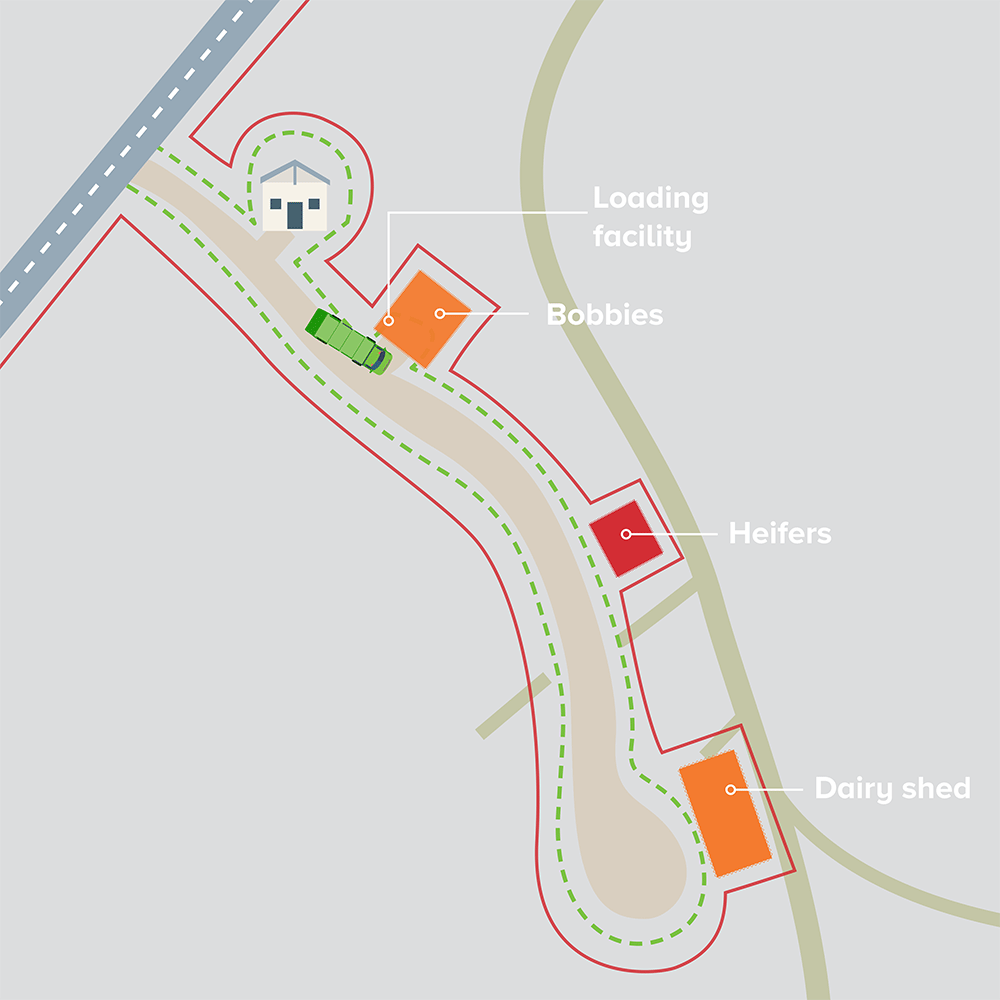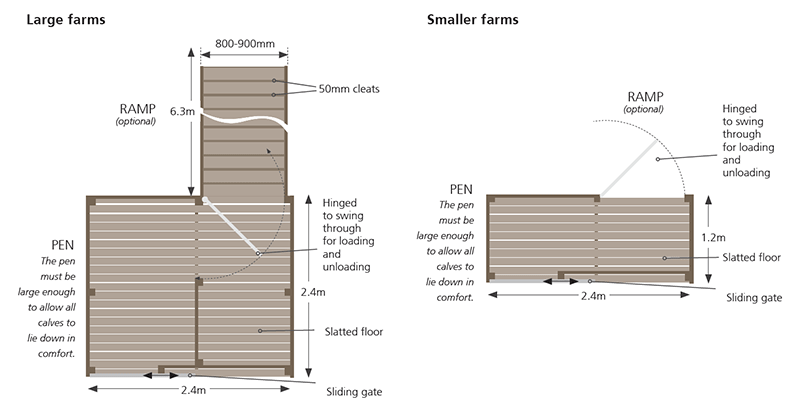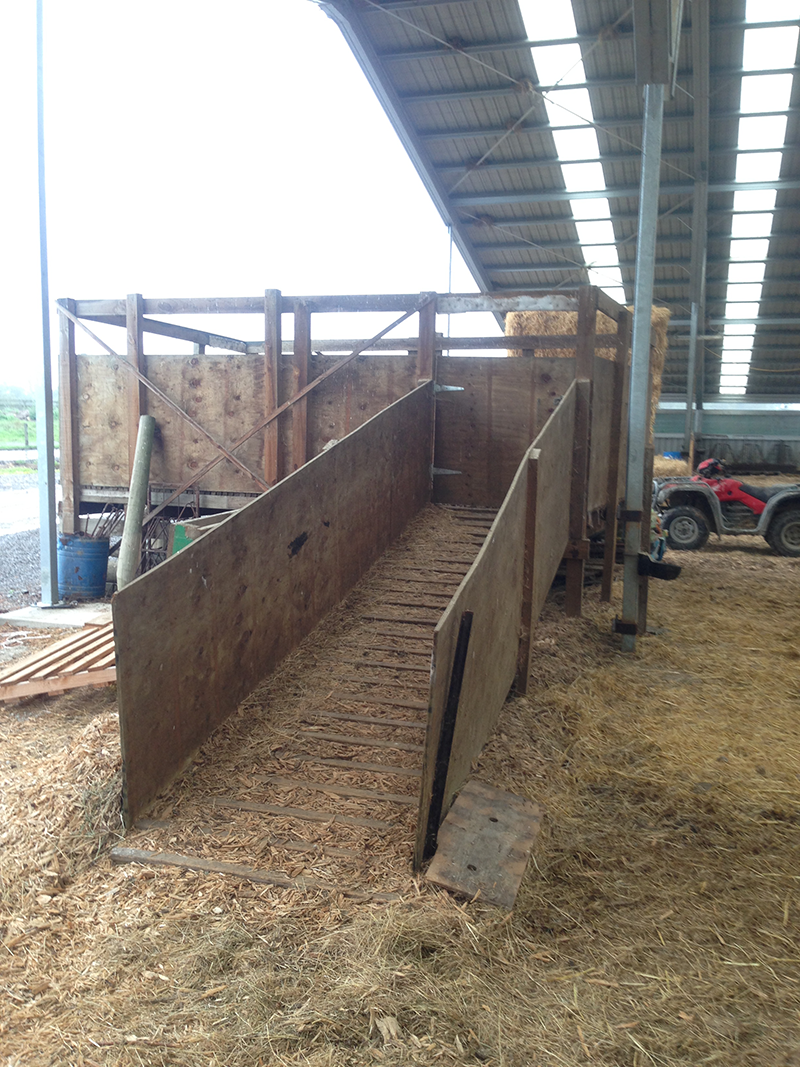A loading platform must be designed such that the cattle can be loaded fast so that the first animal does not get a chance to walk back. The height of the loading platform is determined by the height of the back of the truck or transportation vehicle. As a general directive, a height of 1,1 to 1,2 m for trucks is accepted.
A loading platform that is built at a steep angle causes injuries; therefore, the gradient must not exceed 16°. This is equal to a one-meter increase over 3,5m horizontal distance or a 1,1m increase over 3,85m. Loading platform floors can become very slippery and must therefore be made very coarse. A diamond pattern is recommended. The width of the loading platform is the same as that of a crush, e.g. approximately 750mm. For the collection of cattle, a wider loading platform can be used. The figure below shows the construction of a loading platform.
|
|
Loading Platform
Cattle are normally afraid of heights and a loading platform with a solid floor and solid sides give the best results. Loading platforms must however be provided with swing gates that can swing open into the truck. This will prevent cattle from jumping off between the truck and the loading platform. Telescopic sides which can be extracted into the truck are also suitable, but if they are bent by the cattle, they can impair the operation.
It is preferable that the top of the loading platform should be horizontal for approximately 1,5m. A curved loading platform with an inner radius of 4,5m gives better flow results than a straight loading platform. The loading platform must also have a catwalk on the sides on which the handlers can move to help with the loading process.



Click here to view a video that explains fit to load guidelines.
Tips for Handling Cattle
Keep cattle calm – Calm animals are easier to move and load. When cattle become agitated, it takes up to 30 minutes for them to calm down.
Move cattle at a walk or a trot – Injuries from falls and bruising increase when cattle run into gates and fences.
Reduce noise – Cattle have very sensitive ears and yelling and whip-cracking stresses them. Handlers should not yell or constantly whistle.
Eliminate Electric Prods – In most facilities, cattle can be loaded and unloaded without electric prods. A flag or paddle stick or other non-electric aid should be a person’s primary handling tool. Truckers and handlers must not constantly carry around electric prods. Several feedlots have greatly reduced costly dark cutting carcasses by eliminating electric prods during truck loading. If an electric prod is needed it should be used on a stubborn animal and then put back down.
Use Behavioural Principles – Handlers should be trained so that they understand the behavioural principles of flight zone and points of balance.
Make Cattle Flow – Cattle will move up a ramp and onto a truck more easily if they are quietly driven up to the ramp and immediately loaded. Do NOT allow cattle to stand and turn around in the crowd pen that leads to a loading ramp. Cattle should not be brought up to the loading ramp until the truck is ready to load.
Remove Distractions – If cattle refuse to move up a loading ramp or down an alley, remove distractions that cause them to baulk. Some common distractions are seeing people up ahead, reflections off puddles, vehicles parked near the chute, dogs, or a piece of chain hanging down. Painting the facility one colour to reduce contrast and installing solid fences on-ramps and around pens will often improve cattle movement. Solid sides improve movement because they prevent cattle from seeing distractions outside the fence.
Acclimate Cattle to Handling – Cattle should be accustomed to being moved by a person on foot before it is time to ship them to a packing plant. Cattle that have never seen a person on foot are more difficult to handle and more likely to become bruised or have more dark cutters. Acclimating cattle to people moving them on foot also improves safety for truck drivers and handlers.
Click here to view a video that explains the safe handling of farm animals.
Click on the link/s below to open the resources.
Critical control points for measuring the quality of handling facilities